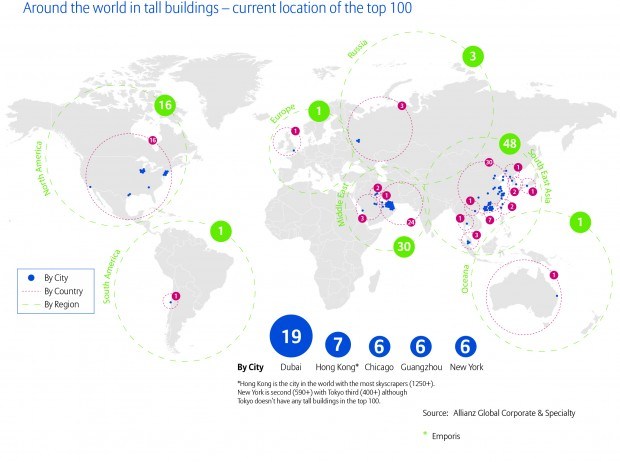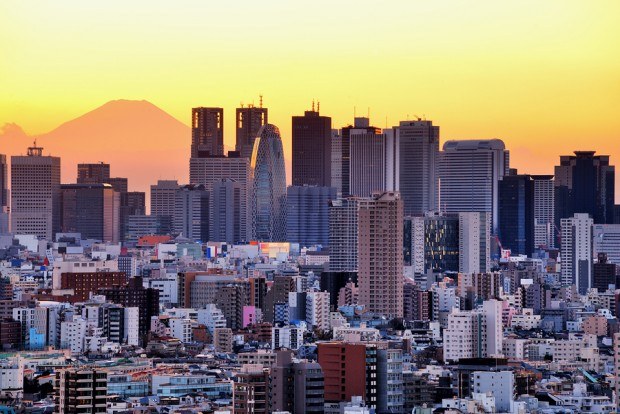As the number of skyscrapers and high rises jumps almost exponentially in Asia and the Middle East, the insurance industry faces major challenges in covering risks from construction to completion and beyond.
Allianz Global Corporate & Specialty draws that conclusion in its report “Supertall Buildings: Construction risk assessment in the 21st century,” and asserts that the industry must find ways to address skyscraper building risks as they shift increasingly from the developed world to developing countries.
“Increasingly complex high-rise building projects present significant risk challenges, meaning insurance claims and risk consulting services are particularly important on a construction site,” the report notes.
The construction shift of these giant buildings has been impressive. According to Allianz, more than 50 percent of the world’s 100 tallest buildings went up in the past four years in emerging markets. Of that number, 59 are in China, Southeast Asia, or the Middle East.
 What is driving this? Allianz said that investor interest, growing populations and lower labor costs in those emerging markets is fueling the trend. By 2020, half of the world’s 20 tallest buildings will be in China, Allianz says.
What is driving this? Allianz said that investor interest, growing populations and lower labor costs in those emerging markets is fueling the trend. By 2020, half of the world’s 20 tallest buildings will be in China, Allianz says.
Compare that to 1930, when 99 percent of the world’s tallest buildings went up in North America, with over half in New York. But today, more than 75 percent of the globe’s tallest buildings are in Southeast Asia and the Middle East. Adding to shifting concerns about risk, those newer tall buildings reign at bigger heights than the older ones. Allianz said that the average height of the world’s tallest buildings is now 358m, up 25 percent from the start of the 21st century.
Property/casualty insurers in these emerging markets must consider potential risks during construction including seismic events, natural catastrophes such as flooding, windspeed, fire, building material risks, and even project sizes, which commonly involve up to 10,000 workers and more than 100 subcontractors, Allianz noted.
And then there are post-construction challenges. They can include problems with glass exteriors high above the ground, building material durability, and changed design plans.
Allianz recommends that insurers pursue meticulous planning, and assess each project regarding pluses and risks involved. All parties in these massive projects must share information and also evaluate past claims to prevent future ones, according to the report.
Coverage can, and should, run the gamut, Allianz said. That can range from risk building and construction protection to post-construction coverage that addresses everything from building defects to workmanship problems.
Those things matter tremendously, Allianz said, because the insured value of today’s newest skyscrapers can surpass $1 billion or higher. That means that these expensive projects may need multiple insurers to offer a project adequate coverage.
“On very high-value coverage, one insurer may not have the available capacity or want to provide the full limits necessary to cover the completed project value,” William Henthorne, Inland Marine Underwriting Manager at Allianz Global & Corporate Specialty, said in the report.
Insurers who take on today’s skyscraper construction projects, particularly in the developing world, must ultimately be flexible, Allianz said in the report.
“Timelines may extend, design plans may alter, engineering challenges may arise,” Stefan Atug, engineering underwriter at Allianz Global & Corporate Specialty Risk Transfer in Dubai, said in the report. “Technical risks may need to be managed or mitigated in different ways. As a reinsurer, we need to be able to take a flexible approach and adapt our services to suit the client’s needs, which means forging as close a relationship as possible to be able to react to changing circumstances.”





















 California Workers Comp Combined Ratio for 2024 Highest in 20-Plus Years
California Workers Comp Combined Ratio for 2024 Highest in 20-Plus Years  NOAA Announces Latest AI-Driven Global Weather Models
NOAA Announces Latest AI-Driven Global Weather Models  What to Expect in 2026: U.S. P/C Results More Like 2024
What to Expect in 2026: U.S. P/C Results More Like 2024 




